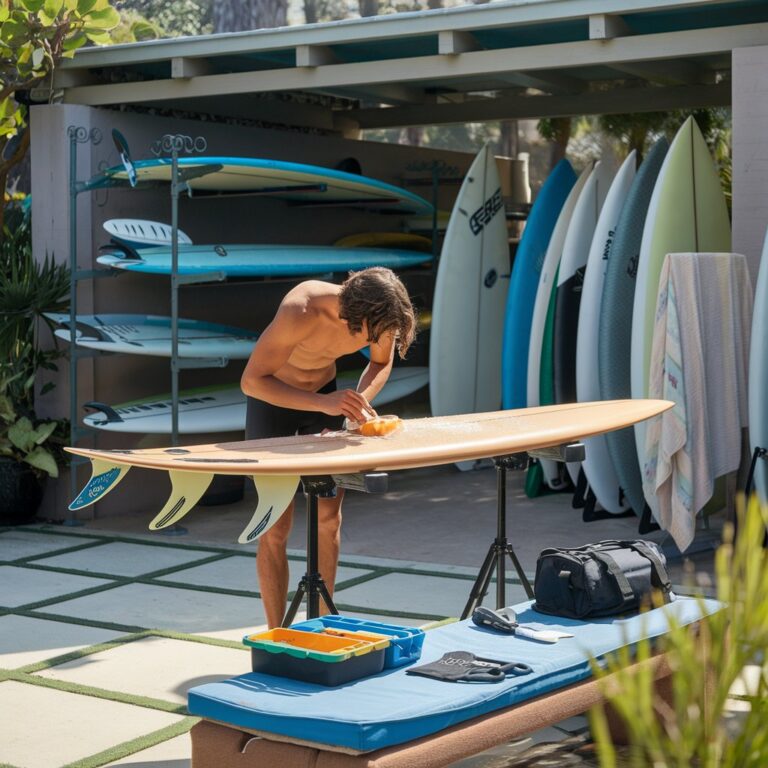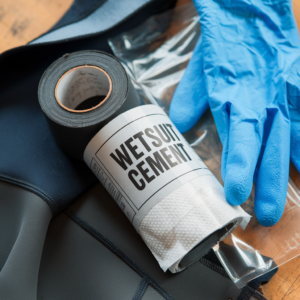News Flash – Your Surfboard Is Aging!
Surfboards are a bit like boats. Without regular maintenance, they age quickly because of constant exposure to salt water and the harsh marine environment.
I saw a young surfer with a new surfboard the other day and he asked,
“How do I make my surfboard last forever?”
Surfboards will age quickly if you don’t take good care of them. The best way to make surfboards last is to fix every ding right away, handle them cautiously, avoid leaving them in a hot car, keep them in a bag when you aren’t surfing and store them in a safe place.
10 Tips to Make Surfboards Last
1. Fix Every Dings Right Away
If you want to keep your surfboards in good shape so they are always ready for the next swell, you need to fix every ding right away.
Keeping your surfboard water tight is the number one goal.
Water is the enemy! If water gets into the foam inner core of your surfboard it will start to cause a number of problems down the road.
Follow these simple ding repair tips:
- If you damage your surfboard while surfing, leave the water immediately
- Dry out damaged areas by placing your board in a cool, dry place
- Take your surfboard to a professional ding repair shop or fix it yourself
- Go Surfing!
Although I have a number of friends that surf with damaged surfboards, I am obsessed with fixing my surfboards as soon as they become damaged.
Surfboards will last longer if you fix dings right away!
2. Don’t Leave Surfboards in a Hot Car
Don’t make this mistake!
Leaving a surfboard in a hot car has been the death of many surfboards over the years. Cars will heat up fast in the hot sun and the materials used to construct your surfboard, like foam and resin will become unstable and start to separate from each other, which will cause significant damage.
Although it may seem obvious, parking in the shade and leaving your windows cracked will help keep the temperature down inside your car.
You wouldn’t leave your dog in a hot car so don’t do that to your surfboards either.
No matter what, avoid storing surfboards in your car when it is hot and sunny!
3. Handle Carefully
Surfboards are damaged more often on land than in the water because of mishandling, this translates as operator error.
My wife and I use the term operator error as a friendly way to say that the person in charge made a mistake.
Protecting surfboards from dings, scuffs, scratches and breakage is much easier when you handle, store and transport them VERY carefully.
Handle your surfboards like they are made out of glass.
4. Bag Your Surfboards
The best way to protect your surfboard and make it last longer is to keep it in a bag at all times when not surfing.
Surfboard bags provide a layer of foam protection around your board.
As well, most bags have a handle and strap which makes your board easier to carry and move around. Additional benefits include internal and external pockets to carry extra wax, fins, keys, towels and sun block.
Surfboard bags may seem pricey but they will save you money in the long run.
5. Watch out in Big Waves
Surfboards are damaged or broken more often when surfing big waves compared to surfing small waves. When surfers wipeout in big waves, surfboards are exposed to a considerable amount of pressure from the breaking waves.
If you don’t believe me, click on the link and check out my post titled, Do Surfboards Break Easily? The 5 Most Common Ways
Many surfers have surfboards that they save for bigger waves because they are specifically designed for those conditions. When the wave conditions get more serious, the consequences are more extreme and surfboard breakage is a common result.
6. Don’t Ditch Your Surfboard
Ditching your surfboard is when you push it away from you and swim under a breaking wave rather than duck diving with your board. This usually occurs when the waves are too big to duck dive.
When a surfboard becomes separated from the surfer it will be uncontrollable and get tossed around by breaking waves. Even if it is attached to the surfers ankle by a leash, the surfboard board can still hit the ocean bottom or come in contact with other surfers and surfboards.
Basically, when you let go or become separated from your surfboard, you don’t have control of what happens next.
7. Be Careful When Doing Airs
An air is when a surfer launches themselves and their surfboard out of the water and then lands back onto the wave surface and continues riding. This is an extreme trick that increases the likelihood of surfboard damage.
An air in surfing is a lot like an ollie in skateboarding. Airs are an extreme trick and there is a lot of pressure applied to a surfboard when a surfer’s feet come back down onto the surfboard during the landing phase.
If you have the skills to execute and air while surfing, be careful when your feet are coming back down onto the surfboard.
8. Stay Aware in Shallow Water
Every time I go surfing at low tide or in shallow water I get concerned about damaging my surfboard.
It doesn’t stop me from going surfing, but I try to do my best to avoid any exposed rocks. As well, I often take an older surfboard when surfing in shallower water so I am less worried about sustaining damage.
I have summarized my top tips below for surfing in shallow water.
- Talk to other surfers and identify the hazards before you go out
- Only take off on waves you know you can make
- Kick out early before it gets shallow
9. Store in a Cool, Dry Place
Storing anything in a cool, dry place is a recommendation that usually relates to canned food items but it relates to surfboards as well.
Finding a storage location where the temperature stays below 80°F is ideal for long term surfboard storage.
Surfboard Storage Tips
- Store surfboards in a bag away from other items that may fall or cause damage
- Don’t stack heavy items on top of your surfboards
- Put them up high in the rafters or suspended from the ceiling
- Hang surfboards on a wall
10. Remove Wax Regularly
Surfers are continually applying and re-applying surfboard wax to their surfboards in order to increase traction.
Wax will build up over time and it is important to remove all the wax every so often.
Once all the wax is removed, you can see the surface of your surfboard more clearly and check for any dings or damage that you may not have noticed.
Depending on how often you surf, removing all the wax every 3-6 months is a great way to keep your surfboard in excellent shape.
In Conclusion
Follow the tips above so you can fight the slow decline of your surfboard.
Making surfboards last longer so you consume less raw materials is awesome for the environment and your wallet.
Keeping your surfboards in top shape will help you create more memories and catch more waves.
Go Surfing, have fun, repeat!
For more insightful tips, read these articles:
Surfboard Traction Pads: Why They Make Surfing Better
17 Tips on How to Attach a Surfboard to a Car’s Roof Rack
Does Skateboarding Help Surfing? 10 Reasons Why




